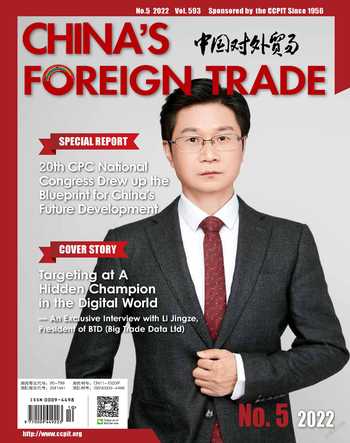SDRI Enterprises Emerging
By Joe Zhang

Recently, Tianyancha Research released the Insight Report for the Top 10 Cities with the Most SDRI (Specialized, Differential, Refined and Innovative) Enterprises (hereinafter referred to as “the Report”), indicating that the number of SDRI enterprises is positively correlated with the GDP, with more than half of the top 10 cities being in the eastern coastal region, with Beijing(of all cities) and Ningbo (of prefecturelevel cities) topping the list. It also shows that SDRI enterprises are mainly found in intelligent manufacturing, computers, communications, and science and technology innovation and service industries that provide support for manufacturing.
More than half of “little giant”firms are in eastern coastal regions
Small and medium-sized enterprises are an important driving force to national economic and social development. According to the Report, SMEs contribute more than 60% of the GDP in China, absorb more than 70% of rural migrant labor, and provide 80% of urban jobs and 90% of new jobs in total.
In terms of geographical distribution, more than half of the top 10 cities, such as Shanghai, Ningbo, Tianjin, Qingdao and Xiamen, are in the eastern coastal regions. In these areas, local small and mediumsized SDRI enterprises have generally stood the test of time, with an average age of nearly 10 years.
According to the data from the Ministry of Industry and Information Technology, the number of SDRI “little giant” companies in the eastern coastal regions has reached 2,626, accounting for 55.15%. Such a layout is closely related to the strong industrial synergy in the Yangtze River and the Pearl River Deltas, where there has been a relatively stable cooperative relationship between upstream and downstream players across the industrial chain. In order to boost the development of the regional manufacturing industry, and promote the establishment of industrial clusters, it is indispensable to enhance the advantages of industrial chain integrity.
There has been intense competition between two important “engines” of Chinas economy, i.e. the Yangtze River and the Pearl River Deltas. As SDRI SMEs became the basic force with which to strengthen the stability and competitiveness of the industrial and supply chains, the development of hightech industries, the commercialization of scientific research achievements and the introduction of outstanding talents have become the new focus.
It is worth mentioning that Ningbo, as a sub-center city of the Yangtze River Delta, has a complete manufacturing system, although its GDP is smaller than those of Chengdu and Tianjin, since it has always focused on building an “industrial city”. According to the Report, Ningbo now is a national industrial city and cutting-edge manufacturing base, and is also the prefecture-level city with the most state-level SDRI enterprises. Furthermore, Ningbo plans to increase the number of science and technology SMEs to 30,000 by 2025, including 6,000 national science and technology SMEs.
Dongguan, the central city on the east coast of the Pearl River, also has a solid “base”. In 2021, the development of Dongguan reached a new level, meaning that it realized a regional GDP of more than RMB 1 trillion and had a population of more than 10 million. As of the end of last year, there were 190,000 industrial enterprises, 11,000 industrial enterprises above the designated size, and 7,387 national high-tech enterprises in Dongguan.
High proportion and number of patents
These SDRI “little giant” enterprises are leading small and medium-sized SDRI enterprises. The emergence of manufacturing individual and invisible champion enterprises reflects the international leadership in production technologies or processes, and of individual products in the global market share.
SMEs that take the lead in market segments have a secret weapon for their success: patents. The Report showed that there was a higher proportion of SDRI SMEs with more than 600 patents in Beijing, Shanghai, Chengdu, Tianjin and Shenzhen.
Beijing topped the list in terms of the number of national SDRI SMEs. Specifically, in Haidian District, which is mainly favored by high-tech industries, there were 117 national SDRI “little giant”enterprises as of June 30, 2022, accounting for 45.5% of the total in Beijing.
Chengdu is a representative of the new first-tier cities with strong innovation capacities and has the most corporate patents on average. According to the Report, in 2021, the scale of the intelligent manufacturing industry in Chengdu exceeded RMB 100 billion, the industrial added value of enterprises above the designated size grew by 11.4%, and there were 4 new national manufacturing individual champion enterprises, while the number of national SDRI “little giant” enterprises reached 107. Meanwhile, biomedicine and rail transportation equipment industry clusters were enlisted as national strategic emerging clusters, and a considerable number of corresponding patents were applied for.
Upgrade of intelligence stimulates new momentum for regional development
According to the Ministry of Industry and Information Technology, more than 60% of small and mediumsized SDRI enterprises in China are in the industrial foundation sector, and more than 70% have been operating in their market segments for more than 10 years.
After years of exploration, expansion and development, a number of enterprises have emerged, filling the gaps and improving the weak links in the five basic sectors of core basic parts and components, advanced basic processes, key basic materials, industrial software, and basic industrial technology. The share of homemade nanoparticles, graphite equipment, submarine cables and so on is growing steadily, forming a relatively safe and controllable industrial chain, and providing important support for the construction of a strong manufacturing country.
The upgrade of intelligence will also in turn force industrial development. Cultivating new driving forces and accelerating the development of SDRI enterprises have become effective ways to enhance regional competitiveness in many places. It was indicated in the “Special Action Plan for Promoting High-Quality Development of SDRI Enterprises in Chongqing (2022-2025)” that by 2025, Chongqing municipality will have cultivated 25,000 innovative SMEs, 2,500 municipal SDRI SMEs, 300 national SDRI “little giant” enterprises, and 25 new publicly-listed enterprises.
In addition to Chongqing, Dongguan is also focusing on the development of SDRI enterprises. According to “Several Measures to Speed Up the Cultivation and Development of SDRI Enterprise in Dongguan”, Dongguan is carrying out an echelon cultivation project for innovative enterprises, and aims to increase the number of high-tech enterprises in the city to 11,000, and that of gazelle enterprises to 1,000, while also developing 100 strong innovative enterprises, promoting the implementation of a number of national and provincial research and development projects in key areas, and fostering a number of invisible champions in specific sectors.
According to the statistics from Tianyancha Research, of the 101 enterprises listed on the Beijing Stock Exchange, 22 are national SDRI “little giant” enterprises.
As Ningbo is a national industrial city and an advanced manufacturing base, enterprises in this city and listed on the science and technology innovation board and the Beijing Stock Exchange are mainly from the manufacturing industry. With the significant benefits of the continuous optimization of the industrial structure and the advancement to “smart manufacturing”, small and mediumsized SDRI enterprises are targeting their development towards becoming listed on by the science and technology innovation board.
SDRI enterprises are an important support for innovation-driven industrial upgrading. According to the Report, Beijing, Shanghai, Shenzhen and other cities are now focusing on cultivating a number of SDRI enterprises of high-growth and strong innovation capacity in high-tech fields such as artificial intelligence, integrated circuits, biomedicine and new energy vehicles.
Supportive initiatives are in place in various regions
The 14th Five-Year Plan for Promoting the Development of Small and Medium-Sized Enterprises which was released in 2021 clarified that during the 14th Five-Year Plan period, China will promote the establishment of one million innovative small and medium-sized enterprises, 100,000 SDRI SMEs, and 10,000 SDRI “little giant” enterprises, and marking the cultivation and development of SDRI SMEs has had unprecedented strategic importance attached to it.
From central to regional governments, a series of policies have been formulated to support the high-quality development of SDRI SMEs, including finance and taxation, credit and financing policies, and measures to boost the upgrading of industrial chains and improve the innovation capacity of enterprises.
The subsidy measures in Shenzhen for SDRI SMEs play an important role in enhancing the stability and competitiveness of the industrial and supply chain and building a new “dual circulation” development pattern by focusing on specialties, strengthening the industry with supporting facilities and winning the market over through innovation. The Report indicated that Yantian District in Shenzhen subsidized enterprises at 50% of the municipal level, with the annual subsidiary for the same enterprise or department amounting to as high as RMB 5 million, making Shenzhen the leader among the top ten cities.
Dongguan accelerated the cultivation and development of SDRI enterprises by encouraging high-quality enterprises to grow to be excellent and bigger, in order to drive the high-quality development of SMEs. According to the Report, in order to improve corporate financing and support enterprises to allow them to get publicly listed, Dongguan gave priority to eligible SDRI enterprises for inclusion on the “white list” of micro, small and medium-sized enterprises and increased loan amounts to RMB 30 million, while guided financial institutions carried out exclusive financial services, including developing financial products exclusively for the SDRI enterprises with a total credit line of not less than RMB 100 billion within five years.
In order to develop more SDRI SMEs, Qingdao implemented favorable measures to develop 100 leading and backbone enterprises, and to increase the number of enterprises with an annual turnover of RMB 10 billion and RMB 100 billion, with the aim of cultivating more than 20 new national SDRI enterprises every year.
With the development and expansion of SDRI enterprises, the number of science and technology-based small and mediumsized enterprises and eyas enterprises have grown year after year in Tianjin, making it an incubation base for SDRI enterprises. As of 2021, there were 133 national SDRI enterprises in Tianjin, and the number of municipal ones grew to 436.
- China’s foreign Trade的其它文章
- The Development of Foreign Trade in China over Last Decade:Higher-level Opening-up to the Outside World
- New Changes in Travel:Past Visitors Are Become Today’s Experiencers
- China’s Livestreaming Enters A New Phase of Development
- The Pension Industry Calls for New Models and Ecology
- Digital Technology Promotes China-foreign Trade in Agricultural Services
- As Shipping Costs“Dive”,It Is Imperative to Improve the Layout of Industrial Chain

